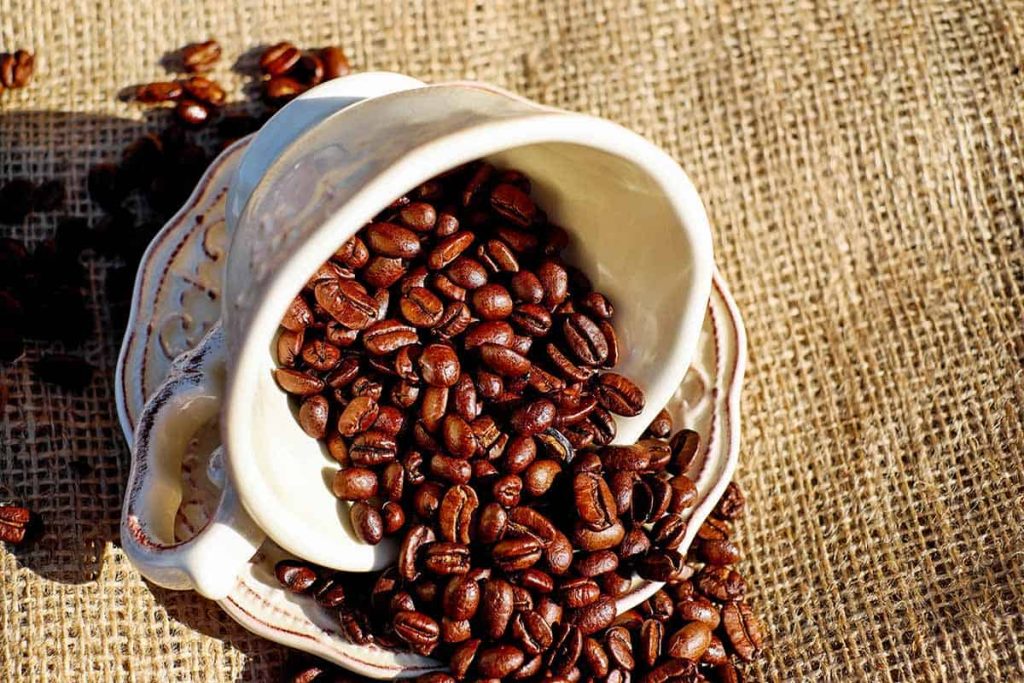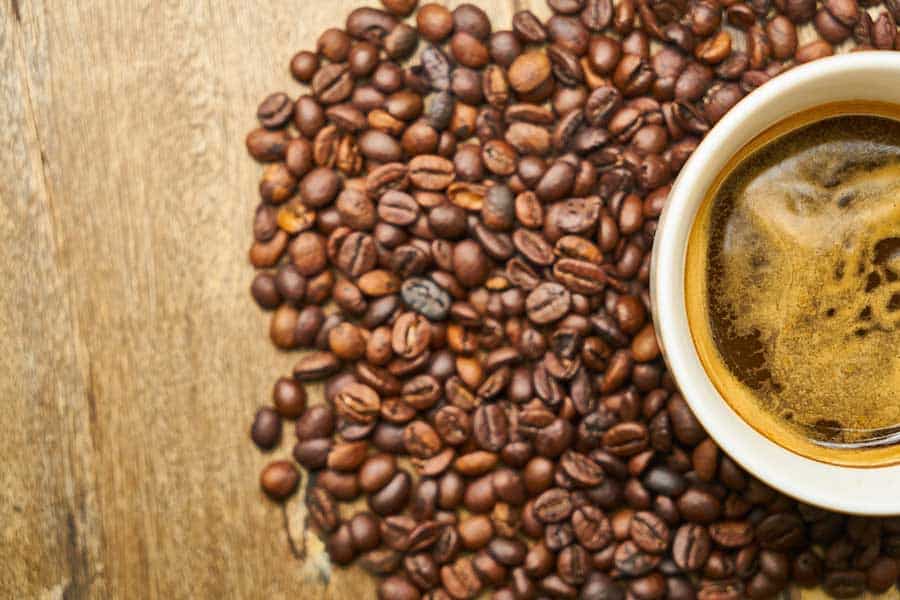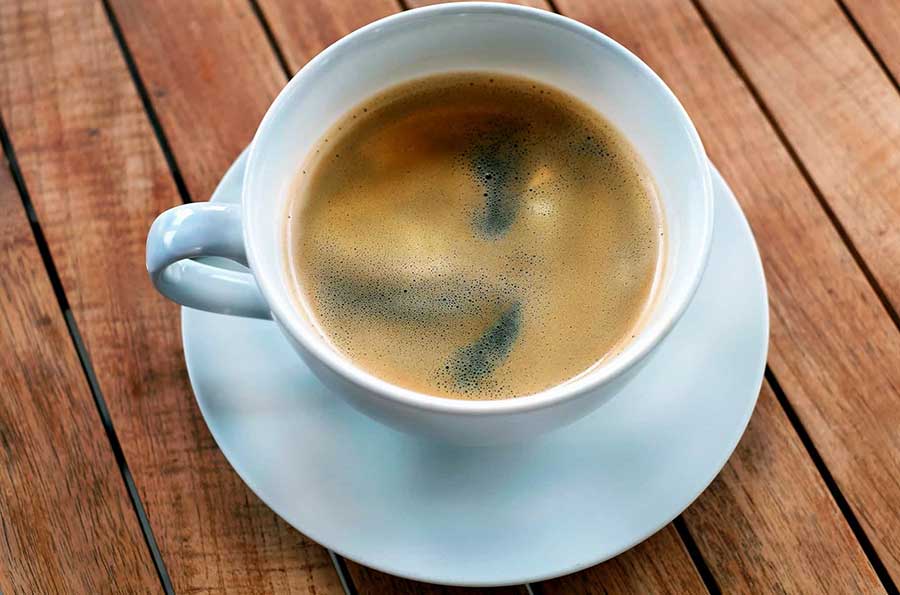How Much Caffeine Is in Espresso Beans: Brewed and Chewed

There was a time when coffee wasn’t brewed and enjoyed as a beverage, but rather was eaten to provide people with a boost of energy. While not as frequent today, some people still enjoy coffee beans as a snack, and this may cause you to wonder how much caffeine is in espresso beans. Whether you are looking to try some chocolate-dipped coffee beans or you are a fan of a warm brew of espresso it is important to know how much caffeine you are taking into your body.
While coffee beans are known for their health benefits, there are some disadvantages to having too much coffee. The obvious reason is that caffeine may keep you awake at night or cause you to feel jittery and anxious. Too much coffee can also cause stomach discomfort due to the acids found in the beans.
Keeping all this in mind, you should keep track of your caffeine consumption each day, and if espresso is your drink then knowing how much caffeine is in an espresso bean will help you keep track.
If you don’t already have quality espresso beans you may want to check out the best beans for espresso which you can enjoy brewed as a beverage or dipped in chocolate as a snack.
What Makes an Espresso Bean?
When asking how much caffeine is in an espresso bean, you may first wonder what the differences are between espresso beans and regular beans. This common question is usually asked because regular coffee beans and espresso beans are branded separately.
The reality is that there is not a particular type of bean that is used for regular coffee and another used for espresso; instead, the difference is in the roasting of the beans. You can buy a pack of raw green beans and roast them for a regular cup or an espresso.
Espresso beans are roasted longer than coffee beans, and you will notice that beans labeled as espresso beans are always either a medium or a dark roast. The longer roast times produce a smoother tasting coffee when brewed using the espresso method.
The short extraction time, fine grind, and high-powered steam from an espresso maker tend to extract the flavors of a darker roast better than the lighter roasts. Lighter roasts offer more complex flavors that are lost when using them in an espresso machine, whereas the darker roasts don’t offer too much complexity but do produce bolder flavors.
Some coffee roasters will produce coffee blends that are designed for espresso; again, this is based simply on roasting the beans a particular way and finding the raw beans that offer flavors that work with the brew method. There are no raw coffee beans that are specific for any roast level or brew. The science and art used when roasting and mixing beans is the reason for bags of coffee beans being labeled for particular brew methods.
All of this may make you think that espresso bean caffeine content is the same as regular beans. While that may be the case, other factors affect caffeine content as well. The roast will retain or reduce the caffeine to a certain extent, and the variation of the bean is another factor to consider.
Do Espresso Beans Have Caffeine?
Simply put, there is caffeine in espresso beans just like there is in regular coffee beans. The amount is determined by the factors I have mentioned above as well as whether you have purchased decaffeinated caffeinated beans.

Decaffeinated beans are made from the same raw beans that you would use for espresso or regular coffee. The difference with these beans is that they are processed before roasting to remove a large amount of their caffeine.
There are several decaffeination methods, and while there is no method that can remove 100% of the caffeine content, they can get fairly close when removing roughly 99.9% of the caffeine from the beans.
If you are purchasing decaffeinated beans, then you will not consume much caffeine at all as the amounts won’t be enough to cause acid problems in your stomach if you struggle with caffeine consumption.
Bean Variation
Firstly, you would need to consider the variation of coffee beans you are consuming. The two most common types are Robusta and Arabica. While Arabica is known for having premium coffee beans that produce better flavors, it contains less caffeine than the Robusta variety.
If you are after a higher caffeine level, then Robusta will be your choice. Generally, Robusta beans contain double the amount of caffeine that Arabica beans do; however, due to the premium flavors and the quality found in most espresso cups, usually Arabica beans are used when roasting beans for your espresso. Keeping this in mind we can determine the caffeine content of espresso beans by assuming they are Arabica beans.
Roast Level
The next factor is the roast level which starts at a light roast and moves to a medium or dark roast with a few options in between these three main levels. While many new coffee enthusiasts may assume that espresso contains more caffeine than other brew methods, this is incorrect.
Espresso offers smoother, bolder, and sometimes more bitter flavors than regular coffee and often it is deemed that this means the shots contain more caffeine; however, the reality is that the shorter roast times for light roasts result in more caffeine being left in the beans.
Since we already established that espresso beans are usually roasted to a medium or dark roast, they are likely to contain less caffeine than your regular light roast coffee beans. The only way to consume more caffeine with espresso is to drink more shots.
Despite the beans themselves having a lower caffeine content, the theory that espresso has more caffeine than regular coffee is not unfounded. Since a shot of espresso is roughly one ounce in volume, drinking one shot results in you consuming less caffeine than an eight-ounce cup; however, consuming eight shots of espresso to reach the eight-ounce mark will definitely result in you consuming a lot more caffeine than the regular cup.
The Breakdown of Espresso Bean Caffeine Content
While keeping in mind the above factors that affect the caffeine content in coffee beans, I am going to outline the caffeine amounts with the assumption that we are using dark roasted Arabica beans for our shot of espresso.
While the factors above are necessary to determine the caffeine content of the beans themselves, we need to break it down even further, since drinking diluted caffeine made in your espresso machine and poured into your demitasse offers a very different amount to the amount of caffeine from eating espresso beans.
Brewed Coffee Beans
When coffee beans are brewed, a certain amount of caffeine is extracted along with the acids, oils, and other components found in the beans. This extracted caffeine is only a portion of the amount that is actually in the beans, so while a typical bag of Arabica beans contains 6 milligrams (mg) of caffeine per bean, when brewed this amount drops to roughly 1-2 mg of caffeine per bean. This roughly works out to a single shot of espresso containing 63 mg of caffeine.
Since there is still leftover caffeine in the brewed beans, you are not consuming the full amount possible. If you ate the beans as they are you would be consuming the full 6 mg of caffeine in these beans.
Coffee Beans as a Snack
Coffee beans are not too tasty when eaten straight out of the bag, and when these beans are used as a snack, they are usually dipped in chocolate first. So, if you are wondering what the amount of caffeine from eating espresso beans is, you would usually need to take the chocolate covering into consideration.
Chocolate is made from cacao beans which, similar to coffee beans, also contain natural caffeine. This amount of caffeine will vary based on the amount of chocolate used to cover the bean, as well as the type of chocolate.
White chocolate contains no caffeine, whereas dark chocolate does contain caffeine. There is 22.7 mg of caffeine per ounce of 70-85% dark chocolate. This is due to the cacao content which is usually signified as the percent of dark chocolate.
Taking the chocolate into consideration, your chocolate-covered coffee snack could contain anywhere between 6 and13 mg of caffeine per bean. It is very unlikely that you will only be indulging in one single bean as your snack, so you need to consider how much caffeine is in a serving size.
The serving size of this coffee bean snack is roughly 40 to 50 grams so you will be consuming about 84 to 182 mg of caffeine per serving. This is a lot more than your typical shot of espresso.
How Much Caffeine Is Too Much

Taking all these factors into consideration, your caffeine intake will vary based on several factors when enjoying espresso beans in your demitasse or in your hand as a snack.While coffee in all its forms is known to have several health benefits, consuming caffeine in excess can also have negative effects on your health. You could get the jitters from too much caffeine, your sleep could be disrupted, or you could experience acid reflux, amongst other effects.
This is why it is important to have an idea of the caffeine content of whatever you’re drinking or eating to ensure you are not exceeding the recommended caffeine intake of 400 mg or less per day.
FAQs
Is it safe to eat coffee beans?
Coffee beans are safe to eat in moderation and offer similar benefits and risks to your cup of joe. Since only a small portion of the caffeine is extracted from beans during brewing, it is important to remember that eating coffee beans will provide more caffeine than an extracted bean.
Raw coffee beans are not pleasant to eat and they are usually consumed in a roasted form and sometimes covered in chocolate. Since unhealthy oils and acids are present in raw beans, it is a good idea to limit your consumption.
Will eating espresso beans covered in chocolate give you energy?
Yes, consuming espresso beans covered in chocolate will provide you with an energy boost throughout the day. Eating the beans is just like drinking a cup of coffee with extra caffeine added.
The beans will contain the full amount of caffeine (while extracted through brewing does not extract the full amount) and the chocolate covering may also contain caffeine. This snack gives you a delicious way to consume some caffeine while enjoying the health benefits and alertness it provides.
Will eating coffee beans help me lose weight?
Consuming coffee beans can aid in your efforts to lose weight if you are mindful when adding them to your diet. There is no single food that can miraculously help you lose weight, but certain foods do contain helpful elements.
Coffee beans are high in antioxidants, and the energy they provide can help you lead a more active lifestyle. The beans also contain a healthy acid called chlorogenic acid which is believed to increase the fat-burning capabilities of your body.
Be mindful of the chocolate-covered beans as they contain sugar, and only eat coffee beans in moderation even if they are covered in dark chocolate.
A Chocolate-Covered Ending
Now that we have determined that there is caffeine in espresso beans and the amount depends on several factors, you can enjoy these beans as a snack or a warm beverage without any guilt. Well, as long as you consume them in moderation and as part of a well-balanced diet!
If you usually buy a bag of pre-ground espresso beans for your machine, you now have a reason to buy whole beans to create a tasty snack with some of them.
Owen is a writer and editor at Caffe Streets who considers himself a coffee fanatic. He spends his time researching and testing different coffee beans and brewing methods and sharing what he learns with others.






